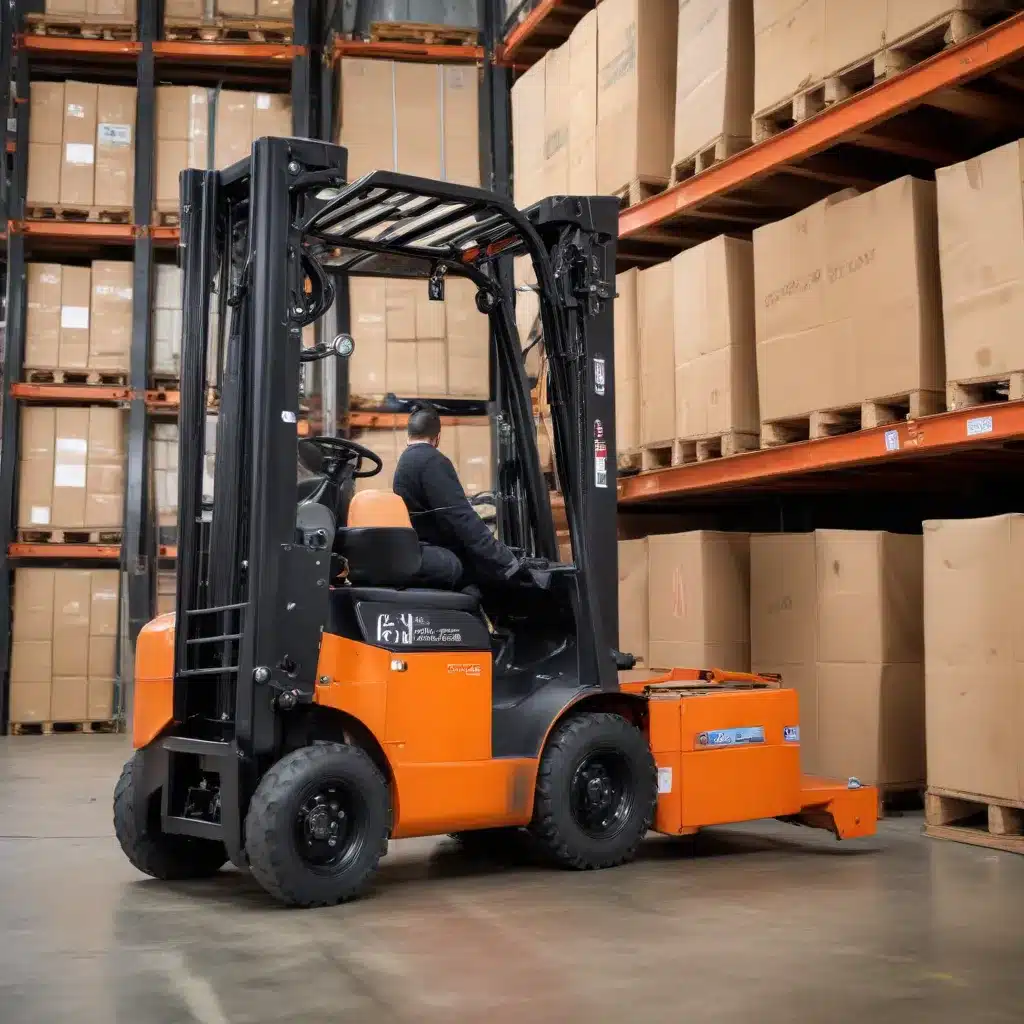
As a seasoned industry expert in forklifts, warehousing, and logistics, I’ve witnessed firsthand the constant challenges warehouse operators face in maneuvering equipment within tight, confined spaces. The need for efficient material handling has never been more critical, especially as businesses strive to maximize storage capacity and optimize workflow. In this comprehensive article, we’ll explore the innovative forklift attachments and specialized equipment that can help you navigate even the most compact warehouse layouts with precision and ease.
Unlocking Compact Storage with Autonomous Pallet Movers
One remarkable solution for optimizing space utilization is the INTRAC, a compact autonomous guided vehicle (AGV) designed specifically for the demanding environment of air freight terminals. With its impressive 15,000 lbs load capacity and electric multidirectional steering, the INTRAC sets a new standard in autonomous AirCargo transport.
The INTRAC’s compact dimensions (3150 mm x 2100 mm x 410 mm) allow it to seamlessly navigate through narrow aisles, enabling block storage and significantly increasing your available storage space. By facilitating this high-density storage configuration, the AGV eliminates the need for wide aisles traditionally required by manual forklifts, freeing up valuable floor space.
Moreover, the INTRAC’s advanced maneuverability and flexible layout capabilities offer unparalleled adaptability to changing storage needs. Its electric multidirectional steering provides exceptional control, allowing the vehicle to execute sharp turns and precisely operate in congested areas. This flexibility is particularly beneficial during peak times when storage demands fluctuate, as you can easily reconfigure your warehouse layout without the constraints of fixed aisles or pathways.
The INTRAC’s power and energy efficiency are further enhanced by its state-of-the-art lithium-ion battery technology, which offers faster charging times, longer battery life, and higher energy efficiency compared to traditional lead-acid batteries. This combination of electric multidirectional steering and lithium-ion battery power ensures the INTRAC remains operational for extended periods, minimizing downtime and maximizing productivity.
Maneuvering with Precision: Forklift Design for Tight Spaces
While the INTRAC represents a transformative solution for air cargo handling, traditional forklift models have also undergone significant advancements to tackle the challenges of compact warehouse layouts. The Linde 346 4-Wheel Electric Forklift, for instance, embodies a range of features that enhance both operator comfort and operational efficiency in tight spaces.
One of the key innovations in the Linde 346 is its compact drive unit, where all drive components are contained in a completely sealed drive axle with an IP54 rating. The dual AC drive motors are mounted in-line, allowing for exceptional run times and minimal wear, ultimately reducing maintenance requirements and downtime.
The Linde 346’s advanced steering system, known as the “combi-steering axle,” allows the axle stub of the rear wheels to be rotated 175 degrees. This exceptional maneuverability enables precise load handling in the tightest of spaces, with a high level of stability even at its maximum load capacity.
Enhancing operator comfort and productivity, the Linde 346 features an adjustable armrest, fingertip controls, a full suspension seat with three adjustment points, and an adjustable steering column. These ergonomic design elements help reduce operator fatigue, ensuring they can work efficiently for extended periods in confined warehouse environments.
Optimizing Narrow Aisles with Specialized Walkie Forklifts
For warehouse layouts with particularly narrow aisles, walkie forklifts, also known as walkie stackers, offer a versatile solution. Unlike traditional forklifts, walkie forklifts are designed with the operator walking behind the machine, rather than seated within it. This compact design allows for exceptional maneuverability in tight spaces, while still providing the necessary lifting capabilities.
When selecting the appropriate walkie forklift model for your warehouse, several key factors must be considered. First and foremost, the width of your warehouse aisles and the height of your shelving will dictate the size and specifications of the walkie forklift you require. Ensuring a perfect fit is crucial to avoid any obstructions or safety hazards.
Lifting needs are another crucial consideration. Carefully assess the maximum weight and lift height requirements for your operations, as this will determine the appropriate model and capacity of the walkie forklift. Matching the equipment to your specific needs is essential for both productivity and safety.
Beyond the physical dimensions and lifting capacities, safety features play a vital role in the selection process. Look for walkie forklifts equipped with advanced safety technologies, such as collision avoidance systems, pedestrian detection sensors, and operator awareness aids. These features can significantly enhance the overall safety of your warehouse operations, protecting both your employees and your valuable cargo.
It’s also important to consider the training requirements for operating walkie forklifts. Ensure that you work with a reputable vendor who can provide comprehensive training and support, equipping your team with the knowledge and skills necessary to safely and efficiently utilize the equipment.
Conclusion
In the ever-evolving world of warehousing and logistics, the ability to navigate tight spaces with precision is a game-changer. The forklift attachments and specialized equipment explored in this article – from the INTRAC’s autonomous pallet moving capabilities to the Linde 346’s advanced maneuverability and the versatile walkie forklifts – demonstrate the industry’s commitment to optimizing space utilization and enhancing operational efficiency.
By incorporating these innovative solutions into your warehouse operations, you can unlock new levels of productivity, flexibility, and safety, all while maximizing the utilization of your valuable floor space. As an industry expert, I encourage you to explore these options and work closely with your equipment providers to find the perfect fit for your unique warehouse layout and requirements.
Remember, the key to navigating tight spaces with precision lies in the careful selection and implementation of the right forklift attachments and specialized equipment. By embracing these transformative technologies, you can elevate your warehouse operations to new heights of efficiency and success.
For more information on the latest forklift reviews, safety guidelines, and industry trends, be sure to visit Forklift Reviews. Our team of experts is dedicated to providing the insights and resources you need to stay ahead in the dynamic world of warehousing and logistics.

